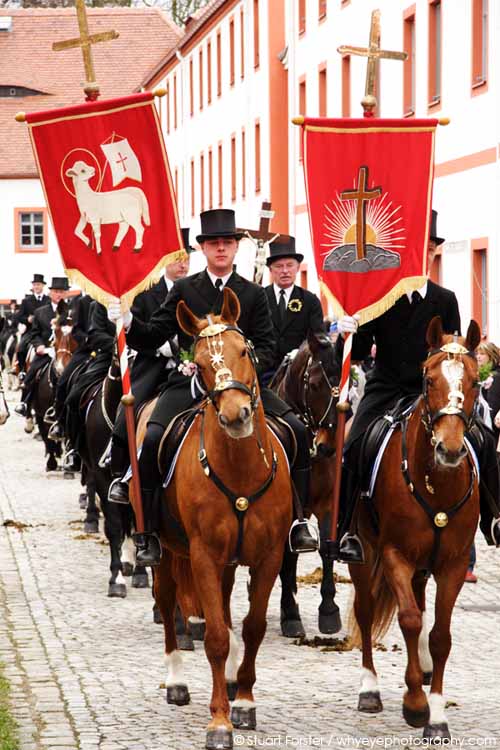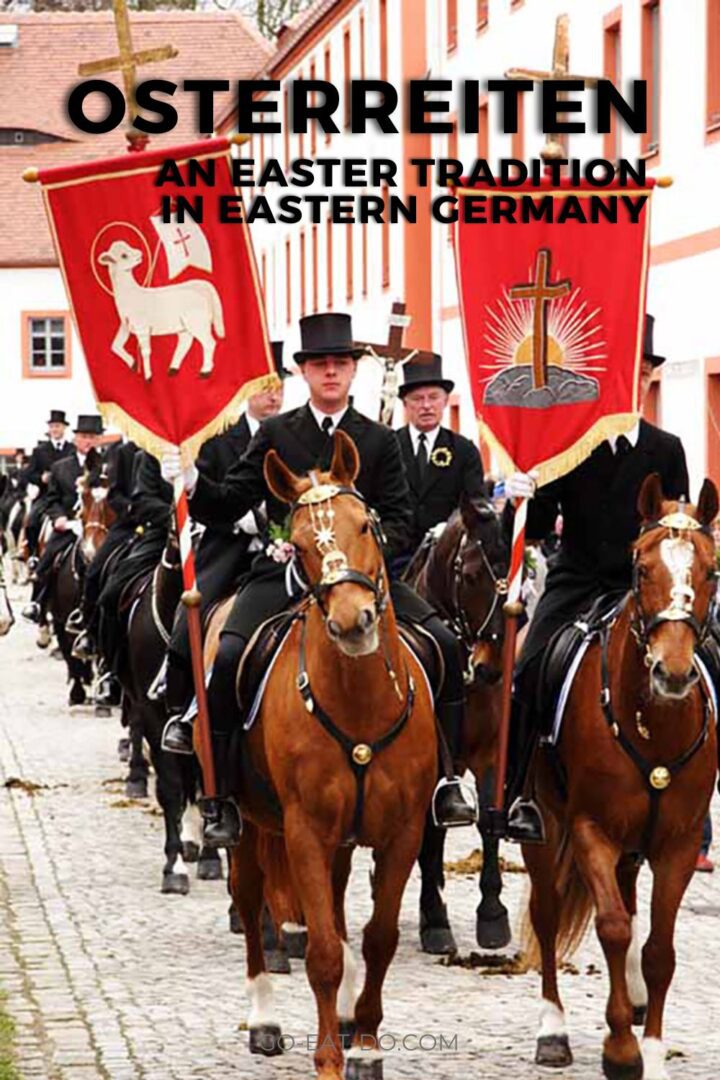Stuart Forster looks at the tradition of Osterreiten – Easter riding in eastern Germany.
Disclosure: Some of the links and banners below are affiliate links, meaning, at no additional cost to you, I will earn a commission if you click through and make a purchase.
“You know Osterreiten, the ‘Easter riding’ tradition of Saxony’s Sorbian-speaking people?” I was asked while dining in Dresden’s Altmarktkeller.
That assumption was wrong, but I was about to learn. Over a couple of black beers served by a waitress dressed in a Dirndl, I heard how eastern Germany’s Roman Catholic Sorb minority had survived two major challenges in the 20th century. The first came from the repressive National Socialists. Then the authorities of the German Democratic Republic made life difficult.
“There are maybe 50,000 Sorbs,” I was told. “They are scattered throughout the towns and villages east of here. Some also live up in Brandenburg.”
Germany’s Slavic Sorb minority
If you take a train through Saxony’s Lusatia district, you’ll spot a number of stations with bilingual place names. They are shown in German and Sorbian, a Slavic language. Bautzen, an attractive city roughly 50 kilometres east of the state capital, is also known as Budyšin.
The story of Osterreiten, horseback processions held by Sorbs on Easter Sunday, grabbed my attention. My hosts, a local couple, suggested we view one of the rides at the Kloster St Marienstern, an abbey in Panschwitz-Kuckau, a village lying on the plains north-west of Bautzen.
Easter riding in Saxony
Osterreiten takes place in towns and villages throughout the region known as Lausutz in Germany. One of the rides parades through the centre of Bautzen.
“You’ll make better photos at Panschwitz-Kuckau because it has a Gothic abbey with tall, arched windows and a white façade with red edging,” I was told.
We parked on Mühlweg, whose name was also shown as Młynski puć on a bilingual street sign.
We walked towards the abbey, passing a war memorial commemorating the fallen of the two world wars and a streetside crucifix bearing golden Jesus and Mary figures. A hand-painted sign read ‘Knjez je nam bliski’, without any translation into German.
Easter eggs on trees
Colourfully painted Easter eggs swung from trees in the gardens of several houses. Attached by ribbons, they bobbed in the wind under the still bare branches, reminding me of baubles hanging from a Christmas tree that’s lost its needles.
Osterreiten is a solemn tradition, undertaken by Sorb men dressed in black. The participants don top hats, long coats, black ties and knee-length riding boots to ride horses in processions accompanied by hymns.
Horse riding in Germany
I was expecting to see mounted figures already present within the abbey’s courtyard, where hundreds of spectators were gathered. As we waited for the arrival of the riders, I heard how a tradition of springtime riding pre-dated the arrival of Christianity about a thousand years ago. Men used to ride across the countryside to banish evil spirits from the fields ahead of the growing season.
Bells rang, announcing the start of the Easter riding. I could make out distant singing before the first hooves clattered against the grey cobbles of the courtyard.
The horses looked well groomed, with flowers adding a flash of colour to their polished halters. The costumes of the men riding in the procession reminded me of pictures I’d seen of funerals in bygone days. To my ear, the tone of their hymns sounded more like a dirge than a celebration of Christ’s resurrection.
Religion in the German Democratic Republic
Religious observance, I’d heard, had been central to the Sorbs maintaining their identity during the 20th century. Traditionally speaking, Saxony is a Protestant state and the Sorbs form part of a Roman Catholic minority. No religion was encouraged during the days of the German Democratic Republic, which ceased to exist on 3 October 1990.
Riders at the head of the parade carried red banners. One depicted the Lamb of God while the other showed a hilltop crucifix in front of the rising sun. Behind them rode a man holding a wooden crucifix bearing a sculpture of Jesus. Some of the men held hymn books but most knew the words by heart.
After circling the courtyard several times, the parade headed out to ride through the countryside and nearby villages.
A window into Sorb traditions
When most onlookers had filed away, I spotted an aged Sorb woman, dressed in black with white lace at her neck. With her headscarf pinned back into the shape of a bonnet and a heavy woollen jacket buttoned to the lace, she would not have looked out of place in a late 19th-century oil painting depicting rural life.
As we drove back in the direction of Bautzen, the slow Osterreiten procession headed across recently ploughed fields. The tradition of Easter riding may not be well-known outside of Germany but it lives on in the Sorb communities of Saxony.

Map of Panschwitz-Kuckau
Zoom in or out of the map below to view details of its location:
Travel to Saxony
Lufthansa flies from London Heathrow to Dresden via its hubs in Germany.
Regional trains provide connections between Berlin and the towns and cities of Saxony.
Hotels in Saxony
The MOMENTS Boutique Hotel and Pension Zum Handtuch are rated among the best places to stay in Bautzen. The Hotel Evabrunnen in Bischofswerda has affordably priced rooms.
Find and book accommodation in Saxony via the website below:
Books about Saxony
Planning a trip to Germany? You can buy the following books via Amazon:
DK Germany travel guide.
Further information
Learn more about Saxony via the Visit Saxony website.
The Germany Travel website has information about Germany and its traditions.
Thank you for visiting Go Eat Do and reading this post about Saalburg Roman Fort in Germany. If you are planning to drive along the Limes Strasse, you may also be interested in this post about Görlitz, Germany’s most easterly city.
Stuart Forster, the author of this post, is a travel writer who speaks fluent German. His work has been published in magazines including Wanderlust, Selling Travel and Discover Germany, Austria and Switzerland.
Photos illustrating this post are by Why Eye Photography.
If you enjoyed this post, please sign up for the free Go Eat Do newsletter. It’s a hassle-free way of getting links to posts once a month.
‘Like’ the Go Eat Do Facebook page to see more photos and content.
A version of this post was initially published on Go Eat Do on 5 April 2015.




